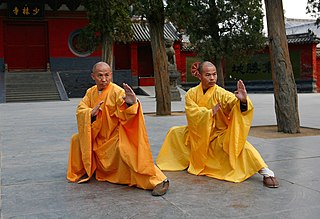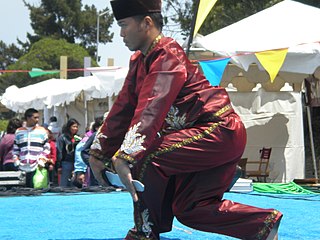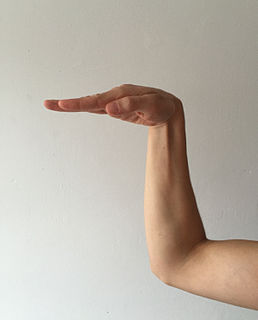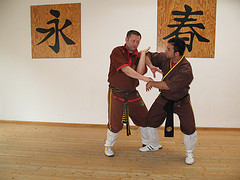 W
WThe Kung Fu Nuns are an order of Buddhist nuns who belong to the Drukpa Lineage, a thousand-year-old sect led by the Gyalwang Drukpa. Their name comes from the order’s proficiency in Chinese martial arts, which they began learning in 2008 after the 12th Gyalwang Drukpa authorized a training program for them despite centuries-old Buddhist laws banning exercise for nuns.
 W
WChoy Li Fut is a Chinese martial art and wushu style, founded in 1836 by Chan Heung (陳享). Choy Li Fut was named to honor the Buddhist monk Choy Fook who taught him Choy Gar, and Li Yau-San (李友山) who taught him Li Gar, plus his uncle Chan Yuen-Wu (陳遠護), who taught him Hung Kuen, and developed to honor the Buddha and the Shaolin roots of the system.
 W
WChoy Gar, also Caijia Quan, is a Chinese martial art deriving its name from the Cantonese-born founder, Choy Gau Lee (蔡九儀), and is one of the five main family styles of Kung Fu in Southern China. It was taught to him by a monk named Yi Guan. This style, founded in the 17th century, is a combination of rat and snake styles emphasizing on swift footwork and rapid strikes.
 W
WA dob-dob is a member of a type of Tibetan Buddhist monk fraternity that existed in Gelug monasteries in Tibet such as Sera Monastery and are reported to still exist in Gelug monasteries today, although possibly in a somewhat altered form. The status of dob-dobs tended to be somewhat ambiguous and they were generally the less academic monks who had an interest in sports, fighting and other 'worldly' matters.
 W
WDog Kung Fu, i.e. Gǒuquán (狗拳), i.e. Dìshùquán (地术拳), is a martial arts style native to Fujian province China. While sharing many similar features to styles like Wuzuquan, Huzunquan, and many others from the same region, this southern style of Chinese boxing has the unique feature of specializing in takedowns, Chin Na, and ground fighting while often taking advantage of utilizing techniques from an inferior position. This martial art also teaches Iron Shirt and Iron Palm fighting methods as well as specialized leaping techniques. Its creation is traditionally credited to a Buddhist nun who developed the style to defend herself from bandits on her travels.
 W
WDrunken boxing is a general name for all styles of Chinese martial arts that imitate the movements of a drunk person. It is an ancient style and its origins are mainly traced back to the Buddhist and Daoist religious communities. The Buddhist style is related to the Shaolin temple while the Daoist style is based on the Daoist tale of the drunken Eight Immortals. Zui quan has the most unusual body movements among all styles of Chinese martial arts. Hitting, grappling, locking, dodging, feinting, ground and aerial fighting and all other sophisticated methods of combat are incorporated.
 W
WWhite Crane Style is a Southern Chinese martial art that originated in Yongchun County, Fujian (福建) province. According to oral tradition, the style was developed by Fang Qiniang, a female martial artist. It is associated with traditional fighting techniques, including long range, but is most similar to close-quarter or hand-to-hand combat. It is most recognizable by the way the fighter imitates a bird's pecking or flapping of wings. While some white crane styles make use of traditional weapons, others have discontinued the use of weaponry.
 W
WFut Gar Kuen or Buddhist Family Fist is a relatively modern Southern Shaolin style of Kung Fu devised primarily from the combination of Hung Ga Kuen 洪家 and Choy Gar 蔡家 Kuen. The style utilizes mostly punches, palm strikes and low kicks, further characterized by evasive footwork, circular blocks and using the opponent's force against him/her.
 W
WBlack Tiger Fist is a northern Chinese martial art originating in Shandong Province.
 W
WHung Fut is a southern style of Chinese martial art, first developed in the early 1800s by Lei Jou Fun 李祖寬 and widely practiced today.
 W
WHung Ga (洪家), Hung Kuen (洪拳), or Hung Ga Kuen (洪家拳) is a southern Chinese martial art belonging to the southern shaolin styles. It is associated with the Cantonese folk hero Wong Fei Hung, a Hung Ga master.
 W
WKuntao or kuntau is a Hokkien term for the martial arts of the Chinese community of Southeast Asia, specifically the Malay Archipelago. It is most commonly practiced in and associated with Indonesia, Malaysia, the Philippines and Singapore.
 W
WLeopard Kung Fu is style of southern Chinese martial arts and is one of the Five Animal styles.
 W
WLuohan quan, which means "Arhat fist", is a general name for all the styles of Chinese martial arts that are named after the Arhats, the holy Buddhist figures. Luohan style is the oldest and the representative style of Shaolin Kung Fu. The original roots of Luohan style date back to the early eras of Shaolin temple. In Shaolin temple, there are various Luohan styles. Besides the Shaolin Luohan styles, there are many Luohan-related styles that have been developed in many other areas of China. Shaolin Luohan 18 hands and Luohan quan are always praised as the root styles based on which most of the Shaolin kung fu styles and many other non-Shaolin styles have been created.
 W
WMonkey Kung Fu or Hóu Quán is a Chinese martial art which utilizes ape or monkey-like movements as part of its technique.
 W
WShaolin Kung Fu, also called Shaolin Wushu, or Shaolin quan, is one of the oldest, largest, and most famous styles of wushu, or kung fu. It combines Ch'an philosophy and martial arts and originated and was developed in the Shaolin temple in Henan province, China during its 1500-year history. Popular sayings in Chinese folklore related to this practice include "All martial arts under heaven originated from Shaolin" and "Shaolin kung fu is the best under heaven," indicating the influence of Shaolin kung fu among martial arts. The name Shaolin is also used as a brand for the so-called external styles of kung fu. Many styles in southern and northern China use the name Shaolin.
 W
WThere are several Chinese martial arts known as Snake Boxing or Fanged Snake Style which imitate the movements of snakes. It is a style of Shaolin Boxing. Proponents claim that adopting the fluidity of snakes allows them to entwine with their opponents in defense and strike them from angles they would not expect in offense. Snake style is said to especially lend itself to applications with the Chinese straight sword. The snake is also one of the animals imitated in Yang family Taijiquan, Baguazhang and Xingyiquan. The sinuous, fluid motion of the snake lends itself to the practical theory that underlies the "soft" martial arts.
 W
WThe movements of the Southern Dragon style of Shaolin Boxing are based on the mythical Chinese dragon. The Dragon style is an imitative-style that was developed based on the imagined characteristics of the mythical Chinese dragon.
 W
WSunmudo is a Korean Buddhist martial art based on Seon, which was revived during the 1970s and 1980s. The formal name of Sunmudo is Bulgyo Geumgang Yeong Gwan. The name Sunmudo was given to this martial art in 1984 by the Buddhist monk Jeog Un.
 W
WWeng Chun Kung Fu also known as Chi Sim Weng Chun is a Chinese Martial Art. Weng Chun in its present form is being preserved by many, including Andreas Hoffman, the successor of the art following late Grand Master Wai Yan.
 W
WWing Chun Kuen, usually called Wing Chun (詠春), is a concept-based traditional Southern Chinese Kung fu (wushu) style and a form of self-defense, that requires quick arm movements and strong legs to defeat opponents. Softness and performance of techniques in a relaxed manner is fundamental to Wing Chun.